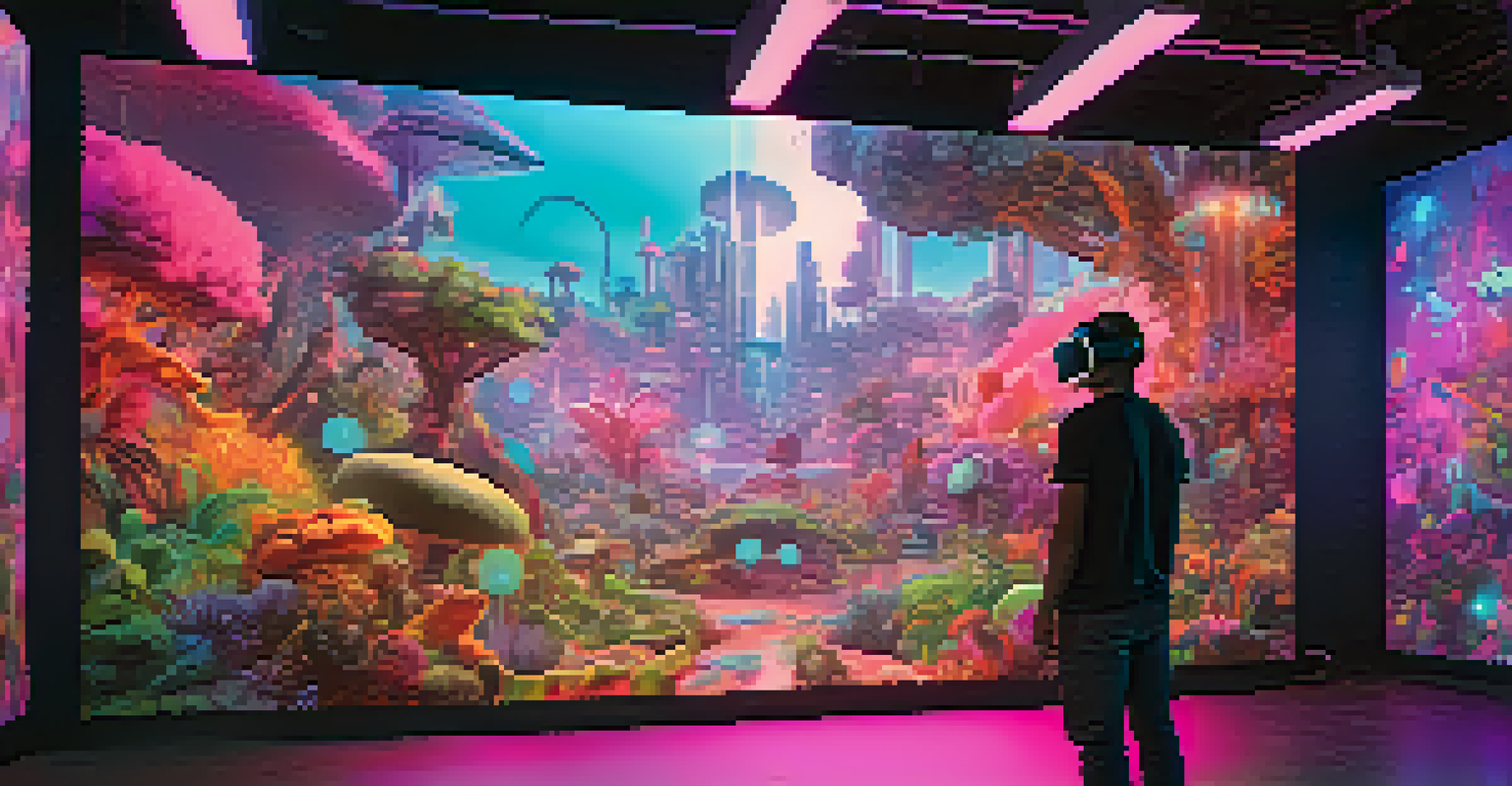The Evolution of Cinematic Technology: What's Next?

The Birth of Cinematic Technology: A Revolutionary Start
Cinematic technology took its first steps in the late 19th century with the invention of the motion picture camera. Early filmmakers like the Lumière brothers showcased simple yet captivating short films, capturing everyday life in a way that had never been seen before. This groundbreaking technology laid the foundation for an industry that would soon evolve and captivate audiences worldwide.
The best way to predict the future is to invent it.
As the years progressed, innovations such as sound in film revolutionized the cinematic experience. The introduction of 'talkies' in the late 1920s not only changed how stories were told but also how audiences connected with characters. Imagine watching a silent film and suddenly hearing dialogue; it was like a whole new world opened up, enhancing the emotional depth of storytelling.
The transition to color films in the 1930s further transformed the industry, allowing filmmakers to create visually stunning narratives. This evolution showcased the potential of technology in enhancing storytelling, as colors added layers of meaning and emotion. From the black-and-white classics to vibrant spectacles, cinema was becoming an art form that resonated deeply with viewers.
The Rise of Digital Filmmaking: A Game Changer
The shift from analog to digital filmmaking in the late 20th century was nothing short of revolutionary. Digital cameras made filmmaking more accessible, allowing filmmakers to experiment without the constraints of traditional film. This democratization of technology opened doors for independent filmmakers to share their unique voices and stories.

Additionally, digital editing software streamlined the post-production process, enabling filmmakers to work more efficiently. No longer bound by physical film reels and editing suites, creators could manipulate footage with greater ease and creativity. This newfound freedom led to innovative storytelling techniques that captivated audiences in fresh ways.
Cinematic Tech Revolutionized Storytelling
Innovations from motion pictures to digital filmmaking have transformed how stories are told and experienced in cinema.
As digital technology continued to evolve, we saw the advent of CGI (computer-generated imagery) transforming the landscape of visual effects. Films like 'Jurassic Park' and 'Avatar' pushed the boundaries of imagination, allowing filmmakers to create worlds and creatures that were previously impossible. With CGI becoming commonplace, the line between reality and fantasy began to blur, enhancing the cinematic experience.
Virtual Reality: Immersive Storytelling Takes Center Stage
Virtual reality (VR) represents one of the most exciting frontiers in cinematic technology. By immersing viewers in a 360-degree environment, VR offers a unique perspective that traditional film cannot replicate. Imagine stepping inside a story, experiencing it from the character's viewpoint—it's a whole new dimension of storytelling.
Technology is best when it brings people together.
With advancements in VR technology, filmmakers can create interactive experiences that engage audiences on a personal level. Projects like 'The Invisible Man' VR experience allow viewers to explore narratives in ways that evoke emotions and reactions like never before. This interactivity not only enhances immersion but also invites viewers to become active participants in the story.
As VR technology continues to improve, we may see mainstream films integrating these immersive elements. The challenge will be balancing storytelling with interactivity—ensuring that the plot remains engaging while allowing viewers to explore. This evolution could redefine how we experience cinema, making it a collaborative art form.
The Influence of Streaming Services on Cinematic Technology
Streaming services have dramatically changed how we consume films and television, influencing cinematic technology in numerous ways. With the rise of platforms like Netflix and Disney+, filmmakers are adapting to new formats and storytelling techniques tailored for online audiences. This shift has led to a surge in original content that often pushes creative boundaries.
Moreover, the accessibility of streaming has democratized the viewing experience, allowing audiences to engage with diverse stories from around the world. Independent filmmakers can now reach global audiences without the need for traditional distribution channels. This has resulted in a rich tapestry of storytelling that celebrates varied cultures and perspectives.
VR and AR Enhance Viewer Engagement
Virtual and augmented reality technologies immerse viewers in narratives, creating interactive experiences that deepen emotional connections.
As streaming services invest in cutting-edge technology, we see improvements in video quality and user experience. High-definition (HD) and 4K streaming have become standard, enhancing visuals and making films more captivating. This emphasis on quality and accessibility continues to shape the future of how we enjoy cinematic experiences.
AI and Machine Learning: The Future of Filmmaking
Artificial intelligence (AI) and machine learning are emerging as powerful tools in the filmmaking process. These technologies can analyze vast amounts of data to predict trends, helping filmmakers understand audience preferences and tailor their content accordingly. It's like having a crystal ball that provides insights into what viewers will love.
In addition to audience analysis, AI can assist in scriptwriting and editing processes. Tools that can generate script ideas or assist in editing can streamline workflows, allowing filmmakers to focus more on creativity. Imagine having an assistant that suggests plot twists or helps refine scenes—this could revolutionize how stories are crafted.
However, the integration of AI in filmmaking raises questions about creativity and authorship. As technology becomes more prevalent, it’s essential to find a balance between human creativity and technological assistance. The future of filmmaking may involve a collaborative effort between humans and machines, leading to innovative narratives that push the boundaries of storytelling.
The Role of Augmented Reality in Cinema
Augmented reality (AR) is beginning to carve out its niche in the cinematic landscape, blending the digital and physical worlds. Unlike VR, which immerses viewers entirely in a digital environment, AR overlays digital elements onto real-world settings. This technology can enhance storytelling by adding layers of interactivity and engagement.
Imagine watching a movie and then using an AR app that allows you to explore the film's universe right in your living room. This kind of interaction can create a more immersive experience, making viewers feel like they are part of the story. It’s a unique way to deepen emotional connections with characters and narratives.
AI Shapes the Future of Filmmaking
Artificial intelligence and machine learning are becoming essential tools for analyzing audience preferences and streamlining the creative process.
As filmmakers experiment with AR, we may see new forms of storytelling that utilize this technology. Collaborations between filmmakers and tech developers could lead to groundbreaking projects that redefine how stories are told. The potential for AR to engage audiences in dynamic ways is vast, and it’s an exciting frontier in cinematic technology.
The Future: Blending Technologies for Enhanced Experiences
Looking ahead, the future of cinematic technology seems to be a blend of various innovations, creating multi-dimensional experiences. Imagine a film that incorporates elements of VR, AR, and AI, allowing viewers to immerse themselves in a narrative while also interacting with characters and environments. This fusion could redefine how we understand storytelling.
As filmmakers harness these technologies, storytelling could become more personal and engaging. The ability to influence plot directions based on viewer choices could create a unique experience for each audience member. This level of interactivity could transform traditional narratives into something more akin to a video game, where viewers have agency.

However, as we embrace these new technologies, it’s essential to remember the core of storytelling: connecting with audiences on an emotional level. While technology can enhance experiences, the heart of cinema will always be the stories we tell and the connections we forge. The future of cinematic technology is bright, and it promises to elevate storytelling to new heights.